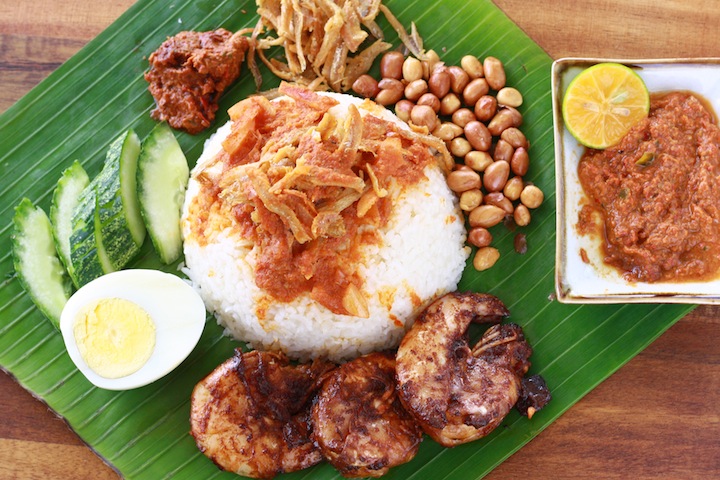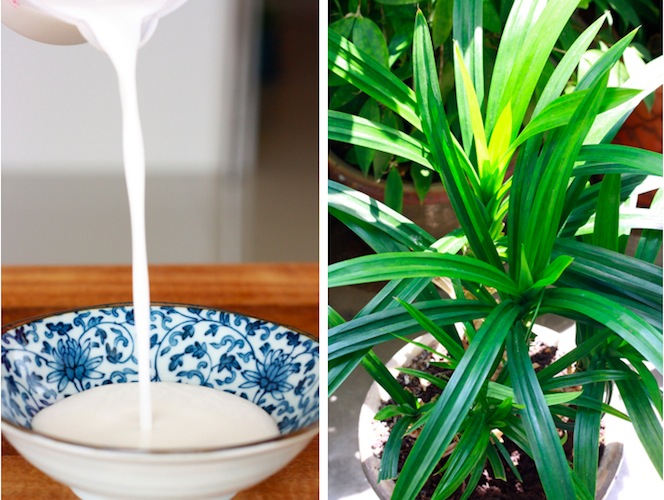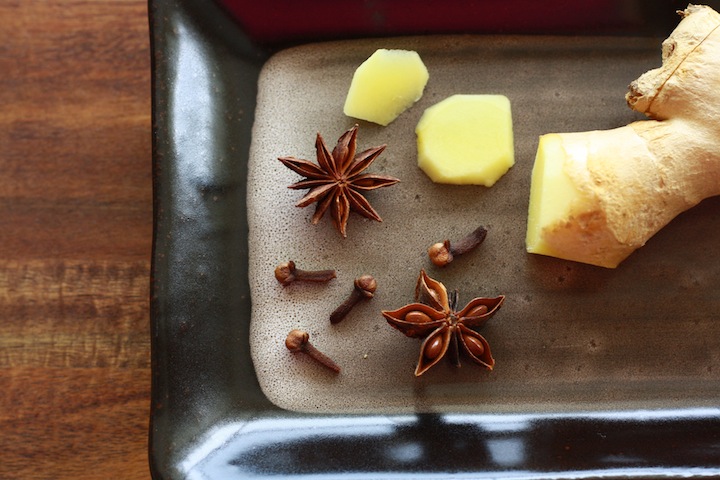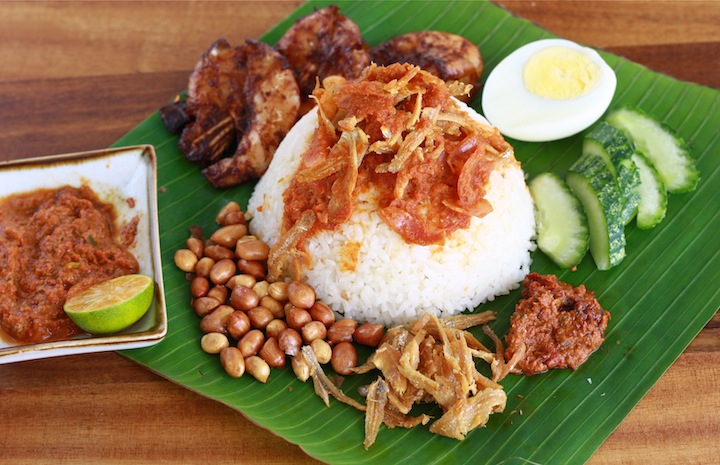Despite the broad diversity of cultures and cuisines in Malaysia, there is one dish that binds us all - Nasi Lemak.
In Malay, 'Nasi' means rice and 'Lemak' means cream or fat, or in this context, coconut milk. But nasi lemak is so much more.
The white rice is cooked or steamed with rich coconut milk, then side dishes are added like fried anchovies (ikan bilis), roasted peanuts, hard boiled egg, fresh cucumber, and sambal. For more elaborate versions, chicken rendang, kapitan chicken curry or sambal prawns are also included. The rice and side dishes are then wrapped up tight into a triangle shape using a banana leaf.
In Malaysia, we enjoy nasi lemak any time of the day - breakfast, lunch, mid-day tea time, dinner and supper. It is the one dish that you can find from the most humbling of roadside stalls, all the way up to the first page of the menu at high class restaurants.
For over 30 years, my grandparents made their living by selling nasi lemak at a market near their kampung (village) in mainland Penang. They would wake up at 4am every day to begin cooking, before leaving to the market at 6am. Once the packets were sold out, they would come home to start the preparation for the next day.
“Your grandparents had to press the coconut milk themselves. They would wrap the grated coconut meat inside cheesecloth, add some water, and squeeze the milk out,” my mom revealed. “Everything had to be made from scratch. Hard work..really hard work."
The lengthy preparation went from pressing coconut milk to cooking rice, grinding sambal, cleaning banana leaves, slicing vegetables, and frying up a mix of side dishes. Once the cooking was complete, my mom and her sisters would take responsibility for wrapping the nasi lemak with banana leaves until the table was lined with a couple hundred or so of the green, pyramid shaped packets. Not until the task was complete, would they would be allowed to leave for school or work.
My mom continued, "When I started working at a factory, I received orders from my coworkers, so I would put the nasi lemak into a basket that I tied to my bicycle, and sell each packet for 20 cents."
My grandpa passed away many years ago, and my grandma is now in her mid 80s, but it wasn’t until recently that my mom shared so much about her childhood with me - including my grandparents' nasi lemak recipe.
It is a buffet whenever my mom makes nasi lemak at home. The accompanying dishes stretch from the classic must haves, to bonus dishes like pickled vegetables, fried chicken, kapitan chicken curry or chicken rendang, tamarind prawns, fried spiced fish, and whatever else she can think up. There is never room for dessert when she serves nasi lemak.
Cooking nasi lemak always begins with the rice.
First and foremost, you need the right amount of coconut milk. Too much or too little will make a world of difference. Then, the Southeast Asian beloved spice - pandan (screw-pine leaves). Distinct, almondy, milky sweet with a tinge of fresh floral notes, the leaves are commonly paired with coconut milk for many delightful Southeast Asian sweet & savory creations.
The fragrant, delicious result will make you wonder why the side dishes are needed at all, as you eat the plain rice out of the cooker.
But as my grandma and mom taught me, hard work always pays off, and no more so, than in making nasi lemak.
Grandpa & Grandma's Nasi Lemak Recipe
Part 4 - Coconut Milk Rice by Season with Spice
Serves 4 hungry stomachs
Ingredients:
2 cups of rice - Thai fragrant rice or basmati rice
3 cups water
1 cup coconut milk
6 pandan leaves (screwpines), tied into a knot.
3 thin slices of fresh ginger or cut into matchsticks
2-3 of Season with Spice's cardamom pods (buah pelaga)
2 of Season with Spice's star anise (bunga lawang)
1-2 cloves (bunga chengkih)
1/4 tsp salt or to taste
The process:
1. Rinse the rice, then add in the 3 cups of water and soak for 30 minutes (without soaking, the rice may not cook properly the first time because of the added coconut milk).
2. In your rice cooker, add in the soaked rice and the water, and the remaining ingredients. Cook the rice, and when it is halfway done, open the cooker and stir well.
3. Continue cooking, and once finished, gently fluff the rice. Let it sit for 10 minutes.
4. Serve the rice with sides such as a hard boiled egg, roasted peanuts, fried anchovies, cucumber slices, and sambal (Part 1). This is the classic nasi lemak, which can be wrapped in a banana leaf and eaten later. To enjoy nasi lemak as a spread, add dishes such as tamarind prawns (Part 2) and sambal ikan bilis (Part 3).
Notes:
-I noticed some confusion with the ratio of rice to water/coconut milk on many nasi lemak posts online, since some cooks use a 'rice cup' for rice, and a normal measuring cup for the liquid. It is best to use the same ratio of liquid that you usually use to cook rice (which should be around 2 parts liquid, 1 part rice). To prevent any mix-up on this recipe, 'Cups' refers specifically to a normal, dry ingredient measuring cup, which I used for both the rice and liquids.
-Pandan leaves and fresh ginger are the essential spices for the nasi lemak. Leave it at that, or have fun adding in some of your favorite spices.
Part 4 - Coconut Milk Rice by Season with Spice
Serves 4 hungry stomachs
Ingredients:
2 cups of rice - Thai fragrant rice or basmati rice
3 cups water
1 cup coconut milk
6 pandan leaves (screwpines), tied into a knot.
3 thin slices of fresh ginger or cut into matchsticks
2-3 of Season with Spice's cardamom pods (buah pelaga)
2 of Season with Spice's star anise (bunga lawang)
1-2 cloves (bunga chengkih)
1/4 tsp salt or to taste
The process:
1. Rinse the rice, then add in the 3 cups of water and soak for 30 minutes (without soaking, the rice may not cook properly the first time because of the added coconut milk).
2. In your rice cooker, add in the soaked rice and the water, and the remaining ingredients. Cook the rice, and when it is halfway done, open the cooker and stir well.
3. Continue cooking, and once finished, gently fluff the rice. Let it sit for 10 minutes.
4. Serve the rice with sides such as a hard boiled egg, roasted peanuts, fried anchovies, cucumber slices, and sambal (Part 1). This is the classic nasi lemak, which can be wrapped in a banana leaf and eaten later. To enjoy nasi lemak as a spread, add dishes such as tamarind prawns (Part 2) and sambal ikan bilis (Part 3).
Notes:
-I noticed some confusion with the ratio of rice to water/coconut milk on many nasi lemak posts online, since some cooks use a 'rice cup' for rice, and a normal measuring cup for the liquid. It is best to use the same ratio of liquid that you usually use to cook rice (which should be around 2 parts liquid, 1 part rice). To prevent any mix-up on this recipe, 'Cups' refers specifically to a normal, dry ingredient measuring cup, which I used for both the rice and liquids.
-Pandan leaves and fresh ginger are the essential spices for the nasi lemak. Leave it at that, or have fun adding in some of your favorite spices.










